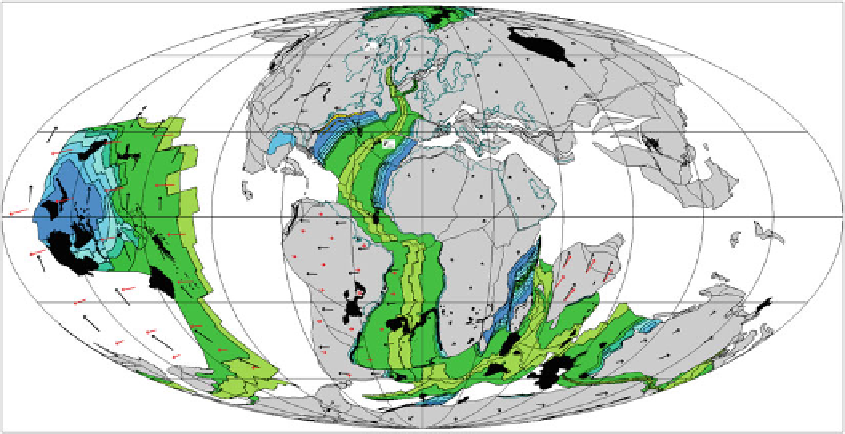Geology Reference
In-Depth Information
Fig. 6.36
Reconstruction at 68 Ma (C31 - Maas-
trichtian), illustrating the acceleration field of the Pacific,
S. American, and Indian plates (
red arrows
) and the global
plate velocities (
black arrows
).
P
IND
,
P
PAC
,and
P
SAM
are
respectively the poles of acceleration of India, Pacific, and
S. America.
Black
areas are LIPS. Coastlines are overlaid
for reference
of a pole of acceleration is often more important
than its magnitude
in the recognition of traction
episodes.
Figure
6.35
also shows that S. America was
moving rapidly southwestward during the Santo-
nian, while the southern part of central Africa was
moving eastward at moderate velocity. These mo-
tions followed an episode of almost instantaneous
increase of angular velocity during the very short
chron M0 (
125 Ma), which was accompanied
by a relevant change of the stage pole locations.
It is not possible to prove that this was an event
of traction, because we do not know the details
of the spreading process during the long CQZ,
although it is interesting to note that the spike
of ! coincided with the onset of the Tristan de
Cunha plume magmatism in the South Atlantic.
A new set of traction episodes occurred be-
tween chrons C31 (
68 Ma - Maastrichtian)
and C25 (
57 Ma - Thanetian). Apart from
the continued northward acceleration of India,
during this stage both S. America and the Pa-
cific plate experienced traction, but with oppo-
site polarities. In fact, while S. America was
decelerating
in this time interval (Figs.
6.24,
6.25
), the Pacific plate
increased
its angular ve-
locity and changed dramatically the stage pole
location (Figs.
6.30
,
6.31
). A reconstruction at
68MaisshowninFig.
6.36
, which illustrates
the strong eastward acceleration of the Pacific
plate between chrons C31 and C25. Such acceler-
ation was necessarily accompanied by increased
spreading rate along the East Pacific Rise (EPR),
which separated the Pacific domain from the
Farallon plate (e.g., Cande et al.
1988
). How-
ever, there is no direct evidence that this episode
was associated with plume activity in the Pacific
area.
An interesting episode of
deceleration
was
experienced by Eurasia between C25 (
57 Ma -
Thanetian) and C21 (
47 Ma - Lutetian). Fig-
ures
6.26
,
6.27
shows that this event was asso-
ciated with a remarkable variation of the stage
pole, while Figs.
6.26
,
6.27
indicates that the end
of this time interval coincided with an abrupt
slowdown in the northward drift of India, pos-
sibly caused by the incipient collision with the
Eurasian margin (e.g., Dewey et al.
1989
; Huchon
et al.
1994
). A plate reconstruction at chron C25
is illustrated in Fig.
6.37
.

